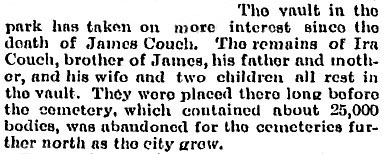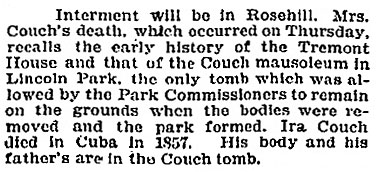Cemetery records are profoundly important to geneologists and historians who track family histories. Interment records may include not only the dates of death and burial, but also the cause of death and information regarding previous interments and subsequent removals. This project has shown me that it was not uncommon for families to move their deceased loved ones several times, for a variety of reasons.
____________________________________________________________________________
Chicago's Graceland Cemetery was founded in 1860, when that area was within the town of Lake View. One of the earliest rural cemeteries, it has a warm and helpful staff who are very accommodating to people visiting their grounds. They have interment books that date back to their first burial - the son of the founder of Graceland, who was transferred there from the City Cemetery. The Trustees of the Graceland Cemetery Improvement Fund graciously allowed me access to their earliest interment records, which detail the dates and names of those who were removed to their grounds from the city's cemetery. As I was compiling The Numbers section of this Web Site, and in accumulating the facts of exhumations from the older burial ground, the Graceland interment information was extremely valuable for my research. I found a total of 2019 individuals who were reinterred at Graceland Cemetery from the Chicago City Cemetery.
The Couch family chose Chicago's Rosehill Cemetery to inter their family members upon the closing of the City Cemetery.
Today's Rosehill Cemetery is run and owned by Service Corporation International, a company with 1,700 funeral and cemetery facilities in North America. SCI also owns Chicago's Oakwoods Cemetery, where the Confederate Mound contains the remains of the Confederate prisoners who were once buried in the City Cemetery potter's field. The staff at the Rosehill and Oakwoods cemeteries must defer to corporate headquarters to answer any questions about their interment records. After nine months of e-mail, telephone calls, written proposals to the corporation, and a visit to the Rosehill cemetery manager's office, I have not yet been able to have anyone tell me anything about the interment records at either cemetery. See more about the significant history of Rosehill, Chicago's first privately held cemetery, here.
____________________________________________________________________________
The question of who rests in the Couch Tomb has presented itself a number of times over the years. Curiously, the white stone tablets that flank the door to the vault are blank, and there is no lettering anywhere except COUCH over the entrance.
The tablets appear smooth, without evidence of engraved or relief lettering, even in the earliest photographs. They look like white marble, a soft stone that smooths easily with
the abrasive force of Chicago weather. Since apart from the monument itself, I found no recorded evidence of individual entombment, the numbers and identities of the people within the tomb seem to be a result of hearsay or speculation. There is also the question of who remains in the tomb. It is possible that the original occupants were removed, leaving the tomb standing empty. But there is no evidence of that activity, either.
_____________________________________________________________________________
By the time Ira Couch died in 1857, two other family members
are already known to have perished
- the Couch patriarch, Ira House Couch who reportedly died in Chicago in 1845, and James Couch's two year old daughter,
who died in 1853. It is possible that Ira and James' mother, Mahitable Magee Couch, also died before Ira, as she is never mentioned in any associated histories of the brothers. The brothers, and later their father, having migrated from New York, adds the possiblity that their mother died in that State. It was not uncommon for families to move
their loved ones' remains, so Mahitable cannot be eliminated from inclusion in the family tomb.
According to the Supreme Court document
that includes a copy of Ira Couch's last will and testament (see the will in the Ira Couch section, at the left.), his mother-in-law and his sister Rachel died before 1877.
__________________________
Beginning with the death of Ira's brother James, the press has speculated on how many individuals are resting with Ira in his tomb. This first account is more than a little confusing in its wording and history. "The remains of Ira Couch, brother of James, his father and mother, and his wife and two children..." Whose wife? Ira's wife lived until 1899, and James' until 1905. And who are the two children? Ira had only one daughter, who lived until 1885. James had two children, only one had died by this time.
Chicago Tribune, February 12, 1892

Chicago Tribune, December 23, 1899, detail from Ira Couch's widow's obituary,

Chicago Daily Tribune, December 10, 1937
From the unsigned column, “A Line O’ Type or Two”
“… Mr. Couch’s father also is buried there, as are several other members of the family and an utter stranger who died in the Tremont house. The Couches are still trying to find out who he was.”
From the column, “When Chicago Was Young” by Herma Clark,
Chicago Daily Tribune,
November 12, 1939
This item says William H. Wood (Ira’s brother in law and trustee of his estate) had two children who died young, one of whom was interred in the vault at the request of Ira Couch’s wife.
Chicago Daily Tribune, May 6, 1951
"So far as is known, Ira Couch’s body was the only one placed in the crypt."
Chicago Tribune, February 14, 1951, from column, “Our Town”
"It is also uncertain how many bodies are buried in the crypt. The Couch family has speculated that others besides Ira are interred in the vault which was built to hold 11 bodies."
Chicago Tribune, August 2, 1960
"Surviving Couch family members, all of whom have moved from Chicago, believe there are seven bodies in the vault. There are five other Couches beside Ira, and a family friend who died at the Tremont house. There are no record of names."
Chicago Tribune, January 3, 1993
In a feature
article in in the Sunday magazine, Anne Keegan wrote,
“The late Johnson Couch, a great-grandson of Ira's, was quoted 40 years ago as saying he recalls his father saying there were 13 persons buried in the vault. Johnson Couch believed, however, that there were only three bodies in the vault - those of Ira Couch; Ira's father, Ira House Couch; and that mysterious hotel guest.”
The plaque that is currently on a signpost marker by the Couch Tomb, states with certainty,
“The remains of six Couch family members and one family friend are in the tomb.”
__________________________________________________________
Even though it would not answer the question of identity, I would think there is a simple way of revealing how many people are entombed in the Couch vault.
Open the door and have a look.
|